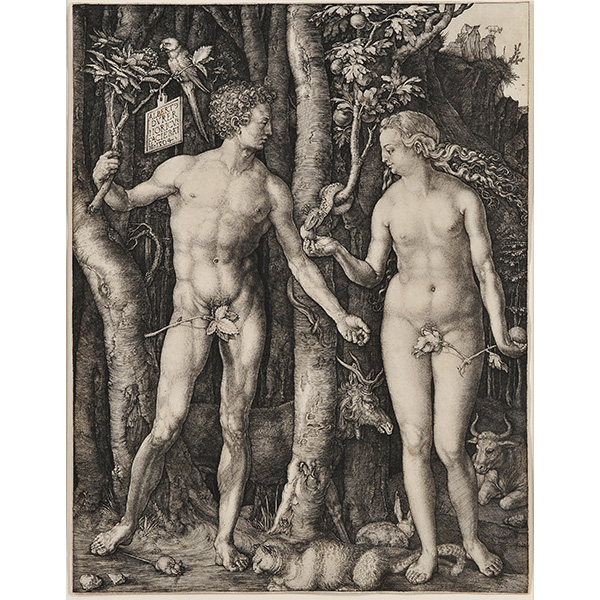
アルブレヒト・デューラー
アダムとエヴァ
1504年 エングレーヴィング、紙 24.8×19.0 cm
Albrecht Dürer
Adam and Eve
Adam und Eva
1504 Engraving on paper, 24.8 × 19.0 cm
この作品はデューラーによる『旧約聖書』を主題とした銅版画です。アダムとエヴァは「創世記」に登場する最初の人類で、彼らは神に創造され、恥じらいや悲しみを知らず、裸のまま楽園に住んでいました。ある時二人は蛇にそそのかされて、神に禁じられていた「知恵の実」を食べてしまい、楽園から追放されます。本作ではエヴァが蛇から「知恵の実」を受け取り、アダムへと手渡そうとする場面が緊張感をもって描かれています。
背景にいるシカやネコなど多くの動物たちは、それぞれこの場面にかかわるシンボリックな意味をもたされています。デューラーや仲間の人文主義者たちは、こうした一見難解な図像に込められた意味を読み解いたことでしょう。
デューラーは、イタリアへの旅行以来、「理想的な人体のプロポーション」を求めて研究を重ねてきました。この銅版画でも著名な古代彫刻をもとに準備を重ね、構図を練りました。ここでは聖書の物語とともに、古代彫刻から学んだ「理想的な人体像」の実現が目指されています。
This work is a copperplate engraving by Albrecht Dürer that depicts a scene from the Old Testament. Adam and Eve, the first humans created by God according to the Book of Genesis, lived in the Garden of Eden, unaware of shame or sorrow, and were naked. One day, however, they were tempted by the serpent to eat the forbidden “fruit of knowledge,” which led to their expulsion from paradise. In this engraving, Eve is shown taking the fruit from the serpent and offering it to Adam, portraying a moment filled with tension.
The animals in the background, including the deer and cat, are imbued with symbolic meanings tied to the narrative. Dürer and his contemporaries in the humanist movement would have interpreted these seemingly intricate symbols with interest and understanding.
After traveling to Italy, Dürer became deeply engaged in the study of "ideal human proportions," drawing from classical sculptures. For this engraving, he carefully studied and prepared his composition based on famous ancient statues. In this work, Dürer sought to combine the biblical story with his exploration of the "ideal human form," embodying the influence of classical art.
